Pergola
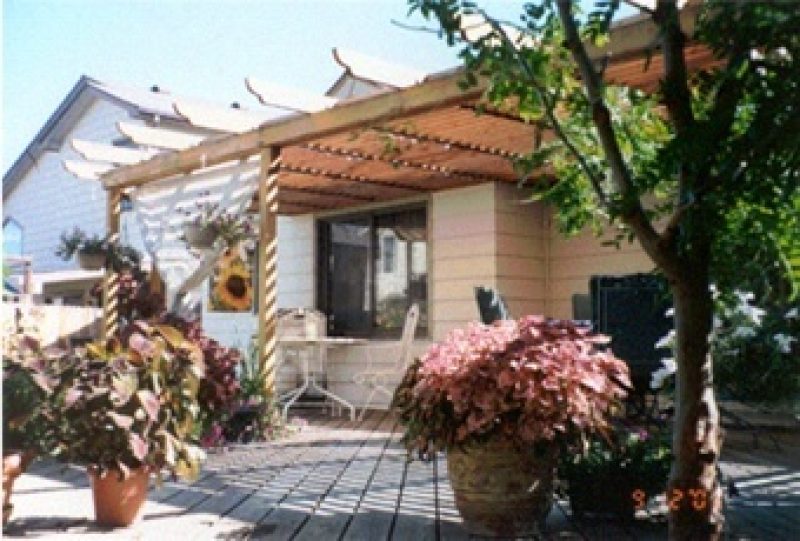
I have a particular look that I am trying to achieve with my home. I want it to appear that it has been here far longer than its actual 8 years. For this reason I use lots of recycled redwood and cedar which I milled on a planer. It provides a nice patina and the nail and knot holes provide the worn look I like.
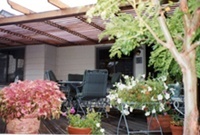
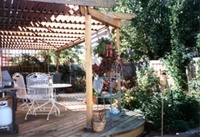
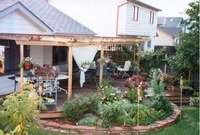
For this project I chose to resaw and mill 2″x 6″ new heart redwood but used normal deck stock rather than clear heartwood. The price is far less than clear stock, and the occasional knot that falls free from the board provides the weathered look.
The deck required allot of louvers which I made in smaller batches to suit the run of a single joist panel. Six panels of 29 louvers each, three panels at 24 each, and one panel with 16 for a total of 262 louvers. Sound daunting? Not so. I found that building and installing one panel per day provided a relaxed pace that permitted me to visit with friends at the lumber yard, fabricate the louvers, and complete the installation by 3 PM.
Here is the sequence I used.
I cut the 2″x6″ redwood to rough length.


Next, I ripped one edge of the stock to 5-3/8th inches wide to fit the brackets and then resawed each piece to yield two louver blanks. The bandsaw was too slow on this operation so I used a cabinet saw. With a little work in setting up the fence and careful handling, I was able to get the thickness very close to equal. ( A 10″ saw will not resaw a 6″ in a single pass so the board must be flipped and sawn from both edges. A simple trick to remember is, always flip the board so the same face stays against the fence for both cuts. This eliminates mismatches from any error in dividing the width.
The piece of ¾” plywood clamped to the saw table is used to mark the 2″x 6″ with a dividing line. If you mark the board from both edges, you can eyeball the center by looking over the board at the blade. Move the fence until the blade bisects the marked lines. You can see a finished louver propped up at the router station to the left of the saw.
I planed the blanks to final thickness making certain to make at least one pass on the exterior side of the original board to expose fresh wood and make it look the same as the resawn side.
Now if you’re following this and you’ve ever worked at a repetitious task, you’ll quickly see that once the original 2″x 6″ blanks are resawn, you have two stacks of book-matched louvers. Keep these stacks in order as you work and you can install the louvers in the same book-matched order. Friends, this is a real conversation starter as you show off your handiwork. I placed louvers with large knot-holes in places where the hole would not be a problem, e.g. under a soffit.
I followed your suggestion of making a “V” groove on each side of the louver but elected to make three of them as I thought the design looked better. This turned out to be the most time consuming operation of the project. I used a router bit to do the work and in retrospect would choose a molding head cutter on my table saw if doing it again. The tip of the router bit, forming the deepest part of the “V” has a cutting speed of near zero and in the slightly wet, soft redwood, it left quite a bit of fuzz which had to be sanded.When doing this operation, I made the center groove first, flipping the louver so the same face stays against the fence to eliminate any error in centering. You can see a ¾” sq. piece of stock between the fence and the louver used to space the outer grooves and a feather board to keep the louver flat on the table. This is a simple setup and effective. The finished louver is in front of the router station.
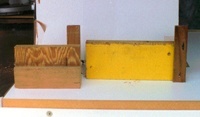
Two of the jigs are shown here pictured from the back and the front. In the left view, the horizontal strip of plywood is placed against the bottom of the joist. The upper horizontal surface locates the spacer strip.
To cut the louvers to final length I made a gauge stick to the length of the shortest louver. Measure the distance between the brackets at each end of the run and in the center to determine if the joists are bowed or tapered. After finding the narrowest point, cut the gauge stick slightly larger and then tweak it to length. Within a few trial louvers, I was able to accurately judge the length of a louver in reference to the gauge stick, i.e. the gauge length +1 saw tooth, etc. In the photo below on the right, you’ll notice a 2″x2″ installed across the joists. These were installed when I framed the deck to assure that the joists remained parallel until I could install the louvers. I installed every other run and then attached a 2″x2″ cross brace to the top of the joists to prevent racking.
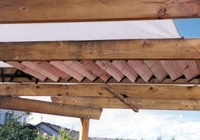
I predrilled pilot holes in the louvers using a self-centering bit for hinges to prevent splitting and installed the operation lever as per your instruction. This fall I will spray the louvers with a preservative and enjoy as many more days as possible on our finished deck.
